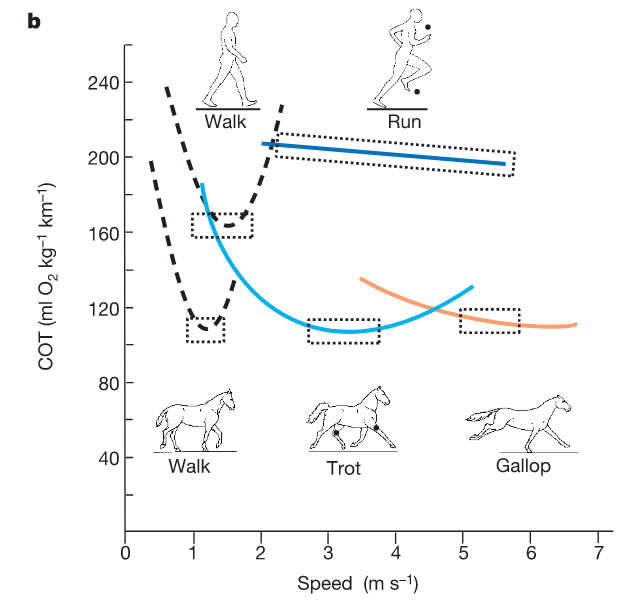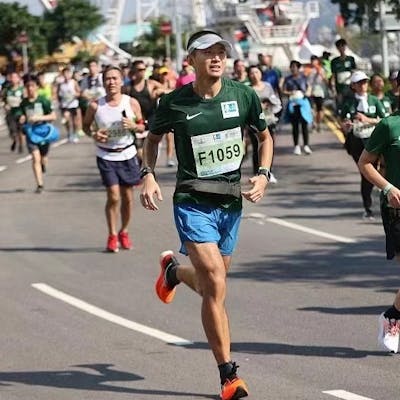What is RER
Here's the exerpt from ADInstruments: ref
Respiratory Exchange Ratio (RER) is the ratio between the volume of CO2 being produced by the body and the amount of O2 being consumed. This value of this ratio gives us an indication as to whether the body is operating aerobically or anaerobically.
Why is RER important?
- Fat is a high density form of energey storage and is nearly unlimited source of energy.
- Carbon (glucose/ glycogen) has a limited storage of 3-4 hours, or 20-30KM running distance, which can be increased by tricking the body (aka carb loading), but still subject to a low ceilling.
- Endurance running over long distance (> marathon distance) mainly utilizes fat as energy source.
- RER measures the mixture of fat v.s. carb at a certain power output.
- When carbon is exhausted, one must lower the power output, or risk at over burning protein (muscle) to complement.
- Lower RER means more fat is burnt & less carbon is burnt, which further means the runner can sustain such power output for a longer time (till carbon is exhausted).
What VO2max tell and not tell
- VO2max is the maximum oxygen consumption, which is in proportion to the maximum energy output.
- VO2max measures the absolute ceiling of sports performance when energy supply is unlimited.
- The above premise is roughly correct for short distance (< marathon), when the athlete utilizes carb loading pre-race or quick energy gels during race.
- During a 100KM run, one can hardly run at a pace that matches VO2max. Knowing the VO2max is nearly useless in this scenario.
How to use RER
Let's denote the below:
- \(V\): current speed
- \(C(V)\): the percentage of energy supplied from carbon source at speed \(V\).
- \(F(V)=1-C(V)\): the percentage of energy supplied from fat source at speed \(V\).
- \(R(V)\): Respiratory Exchange Ratio measured at speed \(V\).
- \(C_0\): Total carbon storage in unit of energy.
- \(P(V)\): power at speed \(V\), i.e. the energy consumption at unit time at speed V
From the definition of RER, we have the equation:
$$ C(V)\times 1 + F(V) \times 0.7 = R(V) $$
Suppose the maximum time one can maintain speed \(V\) is \(T\). We have the following energy equality: $$ C_0 = C(V)P(V)\times T = C(V)P(V)\times \frac{D}{V} $$
From an earlier research, we know that \(P(V)/V\) changes only mildly at a large range of speed for human running pose.
The reference is: Bramble, Dennis M., and Daniel E. Lieberman. “Endurance Running and the Evolution of Homo.” Nature 432, no. 7015 (November 2004): 345–52. doi.org/10.1038/nature03052.
Here is the visualization of human v.s. horse's COT (Cost of Transport) w.r.t. to moving speed and moving pose. One can see that all the curves are U-shaped, but the curve of human's running pose is pretty flat.

$$ COT \propto \frac{E}{D} \propto \frac{P(V)T}{D} \propto \frac{P(V)}{V} $$
Combine this and the above, we know that \(C(V)D\) is a constant for a given body at a given carb loading level. We plug in the first formula:
$$ C(V)\times 1 + (1-C(V)) \times 0.7 = R(V) =0.7+0.3 C(V) $$
Then
$$ (R(V) - 0.7) / 0.3 = C(V) $$
Then $$ D(V)(R(V) - 0.7) / 0.3 = C(V)D(V) \propto constant $$
This translates to
$$ D(V)(R(V) - 0.7) / 0.3 =D(V_0)(R(V_0) - 0.7) / 0.3 $$
If we can find a reference RER at certain speed, and the approximate distance to hold at that speed, we can derive achievable speed or distance at other points.
$$ D(V) =D(V_0)(R(V_0) - 0.7) / (R(V) - 0.7) $$
If we denote \(k=D(V_0)(R(V_0) - 0.7)\) as a runner specific coefficient. The formula can be simplified as:
$$ D(V) =k / (R(V) - 0.7) $$
Example application
For example, my RER is 0.86 at 5min pace, and I can hold a 5min pace for a marathon distance, which is 3:30 hours (actually my PB is 3:19 hours; we leave some buffer here to not entering the anarobic zone).
$$ k=D(V_0)(R(V_0) - 0.7)=42.195\times(0.86-0.7)=6.7512 $$
Let's plug in a few measured data points:
- My RER at 4:00 pace is 1, which means \(D=k/(R-0.7)=22\) -- my energy ceiling is to run 22K at 4:00 pace (with adequate carb loading).
- My RER at 6:40 pace is 0.81, which means \(D=k/(R-0.7)=61\) -- my energy ceilling is to run 61K, at 6:40 pace, roughly 6.7 hours in total. (without eating).
Caveats
There are a few caveats of this calculation:
- The estimated distance at fast speed zone is longer than expected. This may be due to a delay of RER measurement -- The real-time R may be larger than reported, so the division shall have resulted in lower \(D\).
- The estimated distance at slow speed zone is shorter than practical endurance run performance. This is an expected bias, because
- 1) the above calculation does not consider energy intake from food / gel.
- 2) we burn carbon and fat simultaneously no matter the percentage of mixture. Even at a basic metabalism rate of energy output, while staying still, The RER is not exactly 0.7. Suppose my static RER is 0.75, the above two formula gives an estimation of distance at 6:40 to be 77KM, which is larger than previous estimation of 61K.
- Due to different hormone level, one may be able to mobilize more fat than carbon during a long distance race, especially when the carbon level is low. More physiological study can help to refine the calibration.
How to measure RER
The fun fact is, most labs that measure VO2max can produce the report of RER at the same time. The value can be interchangeably referred to as:
- Respiratory Exchange Ratio
- Respiratory Quotient
Following is one real example of my own measurement: (Mar 2023)

One can see that the RQ is in the last column.
Since the measurement was intended for VO2max and Lactate Threshold, the value of RER/ RQ is far from accurate. We talk about the refinements below.
Refinements of measurement
- My Mar 2023 measurement is after lunch. There is active energy intake from food. Since the body tends to utilize more carbon (lazy!) when supply is adequate, the measured RER may be higher, compared to the scenario when I run eseveral hours already on trails.
- There is certain delay of measurement. However, the pace changes every 3-4 minutes. The measured RER may not represent real-time value at that pace. In order to make this useful, it is better to measure at multiple sessions, where we keep a constant pace (after proper warm-up) for long enough duration.
- We need to measure rest status RER to make the forecast useful. The rest RER needs to be measured at different times after meal, 1hr, 2hr, 3hr, ... In this way, we know how the body reacts to the energy source from digest system.
Why is "VO2max" awefully wrong
I specifically put a quote around VO2max because I refer to the "VO2max" as comprehended by most people -- aka the "VO2max" reported by sports watch/ sports software.
Here are a few reasons:
- The VO2max as reported by those devices / software are not one's real VO2max. The latter is genetically deteremined and mainly governed by muscle mass. The former is the result of regression analysis between performance statistics and lab data (which measures real VO2max).
- The sports performance stats may lack variety of data point. Most people do their speed sessions on flat tracks instead of on a slope. So the overall performance of a given VO2max group on slope is relative lower than that on flat. One can choose to run uphill intensity sessions (probably with poles), to trick the regression algorithms to assign higher VO2max, which means nothing of actual improvement of fitness.
- If you look the above table of my VO2max measurement, you would notice one thing -- when the VO2max is measured, the RER is greater than 1 -- in another word, the athlete is leveraging anaerobic at this stage. The same thing happens when one pushes for limits during interval training -- the performance data is gathered during anaerobic phase (meaning energy output without using O2) -- In another word, those who can endure higher lactate level appears to stronger, and thus displaying higher calculated VO2max.
Difference messaging between VO2max and RER
The key message from those two metrics are different, if we use the analogy of cars:
- VO2max -- "This car's max speed is 100 miles per hour by design." -- Issue is that we seldom drive this card to 100 MPH, and in order to achieve that we need stringent road condition.
- RER -- "This car costs 3 gallons per 100 miles at speed of 50 MPH; this car costs 3.2 gallons per 100 miles at speed of 55 MPH; this car cocsts 3.4 gallons per 100 miles at a speed of 60MPH" -- note that RER is not a single value but a series of percentages measure over different speed, aka \(R(V)\) in previous discussions.
Industrial wide implication
Although they appear to be simple metrics of athletic or academic interest, they do have very different impact at industrial level.
The majority of modern long distance running industry is organised around VO2max, from measuring heart rate (so as to extrapolate from submaximal HR to maximum HR), to organising training camps (so as to use interval training to boost calculated VO2max, which may not necessarily improve real VO2max, let alone overall fitness).
There is little issue for short distances like marathon (42KM), where carbon storage is enough for most people to finish, especially with the help of fast carbon intake from digest system. With the help of high intensity training, one can enhance the endurance level of lactate and exert more power for speed.
However, when it comes to long distance, e.g. 100K, or ultra distance >100 miles, carbon is deemed not enough. In this situation, carbon is like the gasoline in above analogy and fat is like "free & endless energy". As ultra runner, our training direction is certainly to use less carbon at a certain speed, so as to maintain that speed for longer distances.
Once you adapt the body to ultra distances with less carbon consumption, the benefit at shorter distances also exhibit. With less fat being burnt at a set speed, you can increase the speed and maintain the same level of carbon consumption rate, so you automatically run faster. This is the rationale behind:
Run Slow to Run Fast.
The gap and the opportunity
One common objection of RER we hear from community is that it is impossible to measure.
Take a step back. How do you measure VO2max 20 years ago? Still recall the time when smart watches/ sport watches were far from mass products?
It is just two step away -- two big steps to easily span a decade:
- Collect lab measurements of actual RER (see refinements section for more details). Collect performance data under a variety of conditions, for the same individuals.
- Build a regression model to calculate RER from performance stats, aka distance, elevation gain, time, heart rate. Additional input like energy intake may be needed to calibrate the data.
ta-da! now everyone has RER displayed on their smart watch.
Real issue
I have full confidence for the future of RER, or more precisely the doctrine/ system of energy based training & racing activities for ultra runners. We have a decade to build whatever we need.
The real issue is about communication and perception.
VO2max, despite not perfect measure for ultra, is at least a positively related value to performance.
As to RER, the value is the smaller the better (approaching 0.7). It is a bit awkward to tell someone "hey your RER is better than mine, because it is smaller".
One way to resolve this is to anchor the communication around \(F(V)\) -- the percentage of fat burnt at a certain speed. This value can be easily inferred from RER measurements.
What do we call this?
- Fat Burning Percentage (FBP)
- Fat Rate / Ratio (FR)
- Fat Engine (FE)
- Carbon Reserve (CR)
- Carbon Efficiency (CE)
- Miles Per Carbon (MPC)
- Ultra Capacity / Capability (UC)
- Ultra Determinant (UD)
- ...
None of those read smooth so far.
We will stick to RER for now, because it is well established concept in academic world. Let's come back to marketing issue later.
Future outlook
We will organize the task forces at three layers:
- Theory -- rethink about distance running using ultra and put energy at the core of endurance science.
- Tooling -- build algorithms, software, databases, labs and wearables to help measure RER.
- Community -- organize envangelists to help non athletes become ultra runners and empower coaches, practitioners and believers with critical resources.

